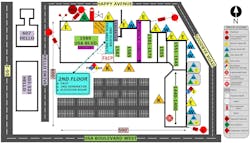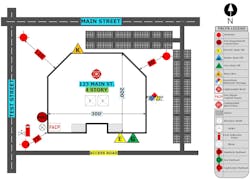There are many uncertainties when going to a structure fire. Anxiety can run high, not just because of the fire but also because of the unknown. However, every department member can do something to help bring the anxiety level down to a workable level. It starts way before the fire does.
Pre-incident plans (PIPs) are something that every member of your crew should be aware of and review periodically. Here are 10 tips to help you to set up a PIP for your crew:
- Pick an address that you’re familiar with. Take your crew and walk through it. As the company officer, explain to your crew what your tactics will be if the fire is in the kitchen or the electrical room. Let them see what everything looks like under optimal conditions.
- Find the hydrants. As you approach the building or complex, your crew should first find the hydrants that are near the property. The hydrant that’s in front of the structure might not be the best choice if the fire is in the rear of the building. It’s best to locate and sketch all hydrants that might be used for your PIP.
- Measure the distance from the hydrant to the building. When you make a sketch of your building, make a note of the locations of the gas shut-offs, the Knox Box, the OS&Y or post-indicator valve, the exterior stairs and roof access. Check the Knox Box to make sure you have the proper keys to do your job.
- Label the crossroads. Make sure that you label roads, cross streets and accessory roads in your drawing. North always should be toward the top of the page for orientation.
- Find the panel. Once inside of the building, find the annunciator panel or FACP (Fire Alarm Control Panel), elevator locations and electrical shut-offs. On your drawing, you can sketch all of the walls and door openings to include inward or outward and window locations. (This step isn’t necessary but does give a clearer picture.) Any room that has hazardous chemicals/conditions must be sketched on the PIP and indicate the chemical or condition.
- Note the hazards. As you walk through the building, write down anything that you deem a hazard or a benefit to help you with firefighting activities, such as a hose cabinet.
- Pre-plan every business. If you are pre-incident planning a shopping plaza or strip mall, make sure to pre-plan every business. Fire can start in one business and spread to others. It’s better to have all of the information than just some of it.
- List an emergency contact. Whatever PIP program you use, you should have a spot to input emergency contact information (i.e., name, the role of the person [owner, HOA representative, manager] and an emergency phone number).
- Describe the building. There also should be spots for construction type, roof construction, length and width of the building and the number of floors.
- Note everything! A PIP should have anything that you deem necessary—anything that can help or save your crew. Is there a high-hazard area? Are there chemicals that someone can fall into? Is there an electrical hazard?
Use the technology
According to "Failing to Plan is Planning to Fail: Capturing the Pre-Incident Planning Needs of Firefighters" (Katelynn A. Kapalo and Joseph J. LaViola Jr.) , despite demographic differences in regions and the size of the population that’s served, most departments report severe challenges in gathering, accessing and retrieving PIPs. The ability to have updated information and access said information must be a goal-orientated perspective that’s recognized by NFPA 1620: Standard for Pre-Incident Planning.
Just a few years ago, every fire engine and EMS transport rescue had one or more large three-ring binders that were filled with hand sketches and contact information on each address that was in the department’s area of response. It was unclear if the information was current or outdated. These days, our units are connected to the internet via laptops, tablets and smartphones. These devices can display the address and dispatch notes and have the capability to route us to the location. You also have the ability to “respond” and “clear” a call by hitting a button. That same device can provide you with your PIP information.
PIP drawings can be extensively detailed, color-coded or very simple. Plazas or strip malls should include all stores and all hydrants on the property.
The goal of a pre-incident plan is to save lives. PIPs aren’t designed to make you an expert but rather to assist you to formulate a plan of attack. If an officer doesn’t use the tools that are provided, it’s an opportunity lost. By understanding the importance of PIPs and overcoming the reluctance of fire crews to create, update and use them, we gain the knowledge that PIPs save lives and property—which is the goal of every fire operation activity.
About the Author
James Hlavenka
James (JT) Hlavenka is 25-year veteran of Palm Beach County, FL, Fire Rescue, serving as a driver operator/paramedic. He has a bachelor’s degree in fire administration from Columbia Southern University and is a Florida state-certified Fire Officer I, Fire Officer II, Fire Safety Inspector I, Incident Safety Officer and Instructor II.

